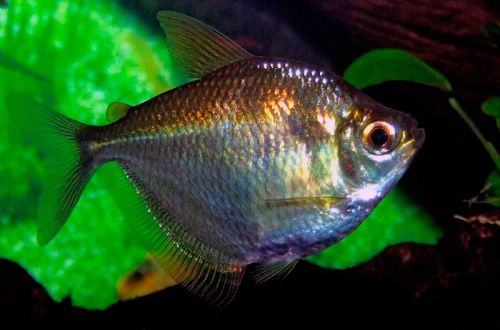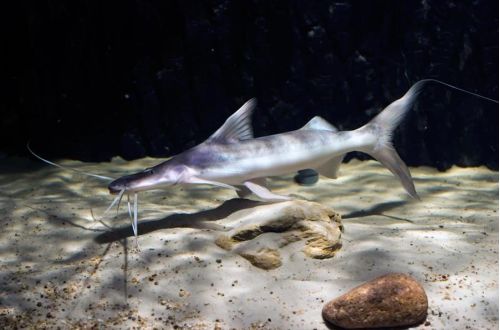
Tetra-Discus
Rounded Tetra or Tetra-Discus, scientific name Brachychalcinus orbicularis, belongs to the Characins (Characin) family. The fish got one of its names because of the similarity in body shape with the popular South American discus cichlid. But unlike her, she is much smaller in size and not so bright. It is quite rare in amateur aquaristics, which is primarily due to the faded color rather than the conditions of detention. This type of Tetra is unpretentious, easy to breed and gets along well with other freshwater species.

Contents
Habitat
Comes from South America. It is considered endemic to small river systems in Guyana and Suriname. Inhabits small rivers and streams flowing among tropical forests.
Brief information:
- The volume of the aquarium – from 100 liters.
- Temperature – 20-27°C
- Value pH — 5.0–7.5
- Water hardness – 1–12 dGH
- Substrate type – any
- Lighting – subdued
- Brackish water – no
- Water movement – moderate
- The size of the fish is 8–9 cm.
- Food – any food
- Temperament – peaceful
- Keeping in a group of 8-10 individuals
Description
Adult individuals reach a length of 8–9 cm. The fish has a high body “squeezed” from the sides, resembling a disk. The coloration is silvery, darker on the back. Sexual dimorphism is weakly expressed, males and females are practically indistinguishable, the latter look somewhat larger during the spawning period.
Food
Omnivorous species, accepts most foods intended for aquarium fish. The daily diet may consist of dry foods in the form of flakes, granules, combined with live or frozen brine shrimp, daphnia, bloodworms and other invertebrates.
Maintenance and care, arrangement of the aquarium
The optimal size of the aquarium for a group of 8-10 fish starts from 100-120 liters. The decoration is arbitrary, but it is desirable that it resembles a natural habitat with the inclusion of such decorative elements as sandy soil, stones and boulders of variable size, driftwood, aquatic plants, etc.
Rounded Tetra needs clean running water with high levels of oxygen and moderate flow. In many ways, a productive filtration system is designed to cope with these tasks. In addition to it, the quality of the water is affected by the regularity of the mandatory procedures for the maintenance / maintenance of the aquarium. These include: weekly replacement of part of the water (30–50% of the volume) with fresh water, timely removal of organic waste (feed residues, excrement), control over the main hydrochemical indicators and concentrations of nitrogen cycle products (ammonia, nitrites, nitrates).
Behavior and Compatibility
A peaceful, mobile fish, however, due to its relatively large size (among Tetras), it can intimidate too small neighbors in the aquarium. Compatible with other non-aggressive species, it can be a great addition to the community of small characins, South American cichlids, cyprinids, catfish, etc. It is recommended to keep at least 8-10 individuals in a flock.
Breeding / breeding
This species belongs to a group of fish that do not have developed parental instincts and do not take care of their offspring, as a result of which the survival rate of fry is low, which, however, is compensated by the production of a large amount of caviar. For example, one adult female is capable of carrying up to 2000 eggs.
There is no seasonality of reproduction in the artificial environment of the aquarium, so spawning can occur throughout the year. The fish scatter their eggs above the ground surface, in a lot of disorder, without forming a local masonry. Eggs are scattered all over the bottom, many of which are not fertilized. If breeding is planned, then the eggs should be carefully moved to a separate tank for their safety. The incubation period lasts about 6 days. In the first days of life, the fry feed on the remains of their yolk sac, and then begin to swim freely in search of suitable food.
Fish diseases
Diseases inherent in this particular species of fish were not noted. When kept in suitable conditions (high water quality, balanced diet, non-conflict neighbors, etc.), health problems are not observed. The most common cause of disease is the deterioration of conditions leading to immune suppression, which makes the fish susceptible to infections that are invariably present in the surrounding area. When the first signs of an illness are detected (lethargy, exhaustion, refusal of food, lowered fins, etc.), it is necessary to immediately check the main parameters of the water. Often, the restoration of acceptable living conditions contributes to self-healing, but if the fish is too weak or has received obvious damage, medical treatment will be required. For more information on symptoms and treatments, see the Aquarium Fish Diseases section.





